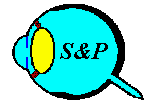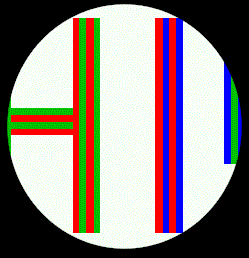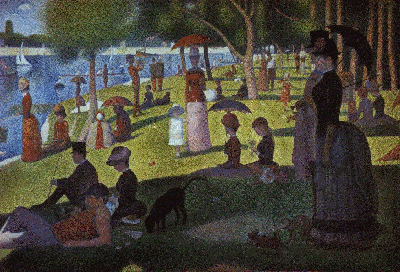

It is basic knowledge that eventually things get to small to see. What isn't so well
known is how the visual system treats the light coming from places to close together that
we cannot tell that there are two places, say two dots, a red and a blue, right next to
each other on your television screen. What appears to happen is that the light is added
together as if it came from one place. For example, look a the color patch behind the word
spatial above. It looks a bit purplish (assuming you have a color monitor). Yet, I made
that patch be red and blue dots with white dots in between. Look closely or even get a
magnifying glass if you need to and you can see the individual dots that are next to each
other.  From the distance of normally reading
this text, the dots are close enough together that it appears purplish which is the color
you get from mixing red and blue. The same type of technique was used to make the
gray
patch behind the word summation. That patch is alternating white and black dots. The
gray
is a mix of black and white. In fact this whole screen works of the same principle. If you
have a color monitor, take a magnifying glass and look close and you will see a whole
bunch of red, green, and blue dots which make all that you see on the screen.
From the distance of normally reading
this text, the dots are close enough together that it appears purplish which is the color
you get from mixing red and blue. The same type of technique was used to make the
gray
patch behind the word summation. That patch is alternating white and black dots. The
gray
is a mix of black and white. In fact this whole screen works of the same principle. If you
have a color monitor, take a magnifying glass and look close and you will see a whole
bunch of red, green, and blue dots which make all that you see on the screen.
The animation to the left is another example of spatial summation. When the letters are big, the stripes of different color are easily discriminated and the differences in color stay distinct. The "H" is red and green, the "I" is red and blue and the "!" is green and blue. Sit back about a meter from your monitor and watch the letter shrink. The animation will keep repeating so take your time. when the shrinking is done, the individual colors mix. The "H" is now orangish, the "I" is magenta and the "!" is cyan (blue-green). Look closely at the screen and you will see I did not cheat. The individual colors are still there in the same stripes as at the beginning.
| Some painters have purposely taken advantage of this mixing
of the eye, called spatial summation. Most notably are the pointillists of which
the leader is Georges Seurat. He painted by placing very small brush strokes right next to
each other which when viewed from a distance will cause spatial summation to occur and for
the desired color to appear and forms to be seen. To the right is a very famous example of
this technique called "Sunday Afternoon on the Island of Grand Jatte. If your software allows it, zoom in and you will better see the points used to map the image or you can try the magnifying glass again. It works best with the large version of the image seen by clicking on the small image shown on this page. |
 Sunday Afternoon on the Island of Grand Jatte by Georges Seurat (1884-1886) |